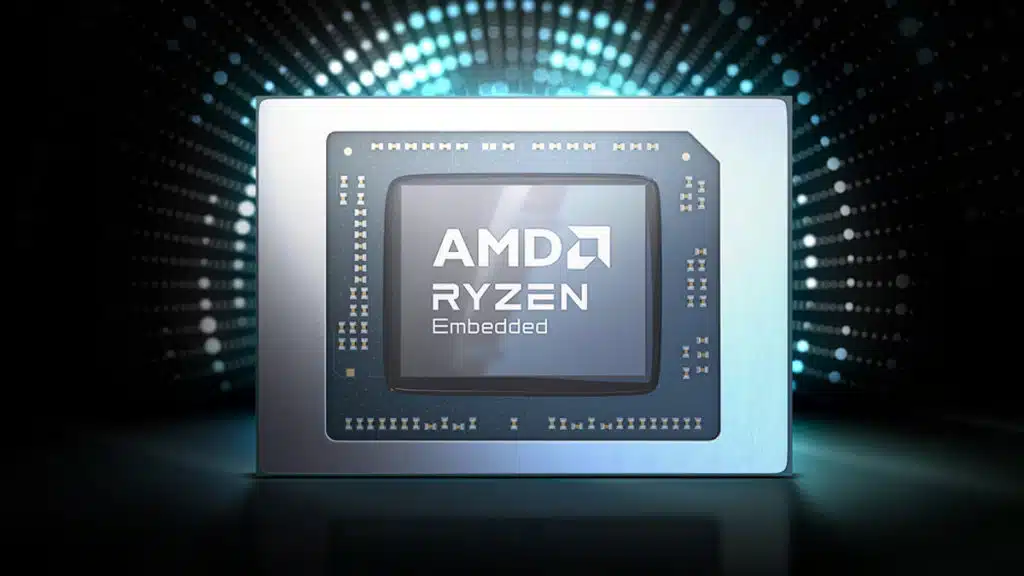AMD has introduced the Ryzen Embedded 8000 Series, the first AMD embedded devices to combine NPUs based on the AMD XDNA architecture with traditional CPU and GPU elements, coupled with Zen 4 cores for improved performance-per-watt and RDNA 3 graphics for what AMD says is optimized visual processing and multimedia performance. The new family is headlined by the Ryzen Embedded 8845HS, a CPU that counts 8 cores and a boost clock of 5.1 GHz among its specifications.
Model specs:
| Name | CPU Base Freq. | CPU Max Freq. | # of CPU Cores | # of Threads | TDP |
|---|---|---|---|---|---|
| AMD Ryzen Embedded 8845HS | 3.8 GHz | 5.1 GHz | 8 | 16 | 35-54W |
| AMD Ryzen Embedded 8840U | 3.3 GHz | 5.1 GHz | 8 | 16 | 15-30W |
| AMD Ryzen Embedded 8645HS | 3.5 GHz | 4.9 GHz | 6 | 12 | 35-54W |
| AMD Ryzen Embedded 8640U | 4.3 GHz | 5 GHz | 6 | 12 | 15-30W |
A product brief:
AMD on its new chips:
AMD embedded products have traditionally leveraged AMD Radeon graphics processing coupled with AMD CPUs, where the GPU has been be used for AI and workload acceleration. However, for next-generation embedded designs, the XDNA architecture and its powerful AI engines are leveraged on the new AMD Ryzen Embedded 8000 Series processors to augment AI performance.
With these resources in play, the full processor performance can scale up to 39 TOPS (trillion operations per second), with up to 16 TOPS offered by the NPU – a powerful profile targeted for demanding, diverse industrial computing workloads. The increased TOPS is achieved by the combination of AMD architectures, AMD XDNA in the NPU, AMD RDNA 3 in the GPU, and “Zen 4” in the CPU, that work together to optimize overall system performance.
AMD Ryzen Embedded 8000 Series processors harness the next-generation AMD “Zen 4” 4nm core CPU architecture, providing powerful x86 CPU compute with up to 8 cores (16 threads). Process node advancements have extended performance-per-watt metrics achieved with previous generation Ryzen Embedded Series devices, enabling AI processing in a comparable power envelope. Supporting scalable thermal design power (TDP) profiles spanning from 15W to 54W, AMD Ryzen Embedded 8000 Series processors deliver a major step forward in industrial compute efficiency for AI applications.
With the help of AMD RDNA 3, a single, small-footprint AMD Ryzen Embedded 8000 Series processor can power up to four independent displays at 4K resolution, leveraging hardware decoding and encoding for popular video codecs including AV1, H.264 and H.265.
They also deliver 20 lanes of on-chip PCIe Gen4, providing ample I/O flexibility for specialized accelerators and other add-ons. AMD Ryzen Embedded 8000 Series processors also feature the latest dual-channel memory support (DDR5 up to 5600MT/s) with support for error-correcting code (ECC) that enables efficient, reliable memory transfer.
This robust set of capabilities is complemented by an open, royalty-free software suite of libraries and inferencing models, and a software development kit (SDK) to optimize and streamline development and deployment. The solution supports the Windows operating system today. It also supports popular AI frameworks including PyTorch and TensorFlow, featuring pretrained models available on HuggingFace.
AMD is partnering with embedded ODMs, including Advantech, ASRock, and iBASE to build a diverse ecosystem of innovative platforms supporting AMD Ryzen Embedded 8000 Series processors. Additionally, AMD Ryzen Embedded Series processors offer extended product availability to help support long-term design lifecycles.
The introduction of the AMD XDNA architecture and its powerful AI engines in select AMD Ryzen Embedded products – marks an exciting new era for these applications opening up AI opportunity in the embedded sector.

